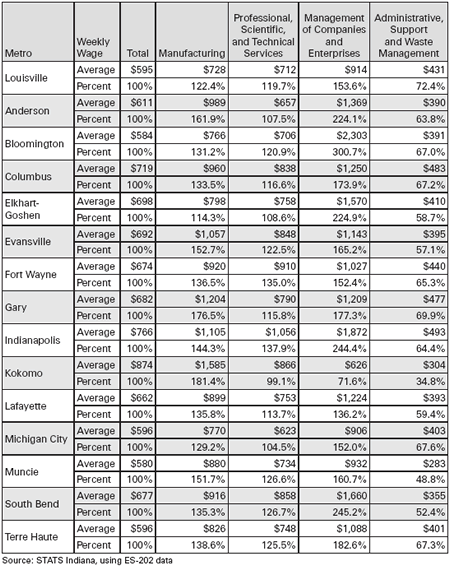The Professional and Business Services Sector: Employment Changes Across Indiana Metros
School of Business, Indiana University Southeast
Indiana University Southeast
As the number one manufacturing state in the country, Indiana’s economy continues to evolve as manufacturing jobs continue to dwindle. In 1990, manufacturing jobs made up 24 percent of the state’s workforce. In 2006, that number was down to 19 percent; meanwhile service-providing jobs increased from 71 percent to 76 percent of the state’s workforce.
Education and health care remain two of the largest service sectors in Indiana, but another important service sector, professional and business services, has experienced growth surpassing both the United States and Midwestern neighbors.
Harpel (2006) suggests that the professional and business services (PBS) sector supports economic growth, and sector growth has been largely positive. (1) This article tracks the PBS sector for Indiana metro areas and provides comparative information on Indiana and neighboring states.
Structural Changes in the U.S. Economy
Economies of the world practicing free enterprise almost always evolve along very similar paths but at different time periods in history. As an economy makes the transition from one phase to another, a radical restructuring of its labor force is typically observed. This process can be especially painful for workers in sectors that are slow to adapt to changing conditions.
Economies start out as being almost exclusively agricultural in nature. The United States began this evolutionary process during colonial times when over 90 percent of all workers made their living in farming. As late as the Civil War, more than two-thirds of workers were still employed in agriculture. By the 1920s, more than one-fourth of U.S. workers were still in agriculture, but the percentage of agricultural workers has dropped to about 2 percent since then—with a corresponding massive reduction in the number of farms. States that held on to agriculture as their economic mainstay became economically depressed, particularly when compared to states that embraced the transition to manufacturing economies. By 1925, employment in the manufacturing segment of the economy surpassed employment in agriculture. Manufacturing employment peaked at 19.4 million in 1979 but has subsequently continued to decline to 14.2 million workers as of December 2006. New manufacturing jobs in the United States seem unlikely, with typical projections calling for another half-million or more manufacturing job losses in the coming decade. Such losses can be attributed to increasing automation, improved efficiency, foreign competition, and outsourcing.
Meanwhile the service sector of the economy continued to make significant advances. In 1979, there were 64.9 million U.S. service workers; by December 2006, the number had surged to 113.9 million. The ratio of service workers to manufacturing workers increased from 3.35 in 1979 to 8.05 as of December 2006.
Replacing manufacturing jobs with service jobs often translates into painful wage losses; manufacturing jobs pay 23 percent more than service sector jobs on average. Service jobs are typically thought of as including retail salespeople, food service workers, customer service representatives, janitors, hairdressers, and groundskeepers. U.S. Department of Labor statistics for 2005 verify a significant difference in average mean earnings for these service sector jobs when compared to production jobs. Whereas production jobs paid a mean average annual wage of $29,890 in 2005, food preparation and service jobs paid a mean average annual wage of $17,840 and personal service jobs paid a mean average wage of $22,180.
Fortunately, not all service-related jobs produce lower wages. The service industry also encompasses new job opportunities driven by the transition to a knowledge-based economy. This type of economy is often called an information society where an increasing number of employees work in information jobs that are based on services, education, and creative activities. This transformation is the byproduct of technological progress and the increasing importance of computer technology. An information society generates a large number of high paying jobs that involve working with knowledge and a declining number of jobs that demand low cognitive skills.
The professional, scientific, and technical services subsector is one of the fastest growing sectors in advanced economies and reflects the growing importance of specialists and specialized knowledge (applied knowledge) vs. generalists. Ultimately, the investment in knowledge determines the productivity of the employee, more than the tools, machines, and capital available. The good news for technology specialists is that these jobs pay relatively high salaries. The Dice salary survey found that technology professionals had average 2006 salary increases of 5.2 percent to $73,308 in 2006—up from $69,700 in 2005. (2) Strong demand for technology professionals is documented by starting salary increases of 13.1 percent to $42,414 in 2006. Those with one to two years of technology experience saw 13.8 percent increases. The strong performance of the technological sector of the economy suggests that we take a closer look at jobs that are coded by the government as professional and business services.
The Professional and Business Services Sector
The professional and business services (PBS) sector includes three subsectors:
- Professional, scientific, and technical
- Management of companies
- Administrative, support and waste management
The first two require a higher skill level and educational attainment. The last, administrative and support services, generally provides routine services to business, including administrative services, janitorial and building support, travel services, and security. Employment services is the largest component of administrative and support services accounting for almost half of total business services. From an economic development standpoint, administrative and support services serve an important role in overall staffing, especially during tight labor markets.
While all are important components in the PBS sector, the first two provide the technical support to other business sectors that enhances their ability to successfully compete in a global economy. The professional, scientific, and technical services subsector consists of activities such as legal advice, accounting, architectural, engineering, specialized design services, computer services, consulting services, and research services. The management of companies sector consists of firms that hold equity securities in companies for the purpose of controlling and influencing management decisions.
Employment in the professional and business services sector has demonstrated steady growth and reached an all time high in 2006 with 17.5 million employees nationally. PBS sector jobs export services to other geographic regions and often result in a strong multiplier effect for local economies. The PBS sector stimulates innovation, creativity, and entrepreneurial activity and is often credited with being a major factor determining new facility announcements between 1999 and 2005. (3,4)
Indiana’s Performance
As the state continues to replace manufacturing jobs with service sector jobs, the PBS sector serves an important role in overall job growth and business attraction. In fact, one may view the professional, scientific, and technical subsector as another version of manufacturing: manufacturing of ideas and creativity. Since manufacturing is still an important component of Indiana’s economy, changes for the goods-producing and manufacturing sector are also discussed. With the exception of Kentucky, Indiana has fared better than neighboring states in overall job growth, as well as job growth for the manufacturing and the professional and business services sectors. This article focuses only on percent changes and annual growth rates as opposed to absolute changes.
Total Nonfarm Payrolls
Indiana lagged behind the United States with respect to change in total nonfarm payrolls from 1990 to 2006. The approximate 18 percent change in nonfarm payrolls lags the overall U.S. change of 24 percent (see Figure 1). However, Indiana surpassed its neighboring states with the exception of Kentucky.
Figure 1
Percent Change in Total Nonfarm Payrolls in the Midwest, 1990 to 2006
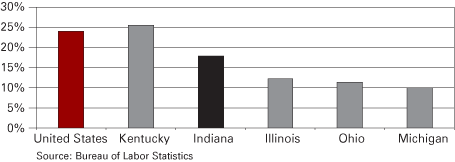
Four metropolitan areas in Indiana exceeded the U.S. change in job growth. Bloomington, Columbus, Elkhart-Goshen, and Indianapolis all exceeded U.S. job growth over the period 1990 to 2006 (see Figure 2). Anderson, Kokomo, and Muncie experienced negative changes in total nonfarm payrolls, with Anderson observing the largest decline.
Figure 2
Percent Change in Total Nonfarm Payrolls in Indiana Metros, 1990 to 2006
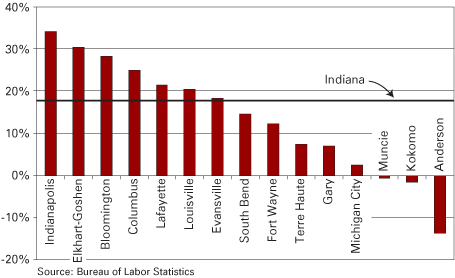
Five-Year Trends: We observe lower annual growth rates over the most recent five-year period. Even though Indiana added jobs, the rate of growth slowed compared to the rate observed from 1990 to 2006 (see Figure 3). Despite this slower growth, Indiana added more jobs than its neighboring states, with the exception of Kentucky. Indiana again lagged behind the nation with respect to the annual growth rate.
Figure 3
Annual Growth Rates in Total Nonfarm Payroll
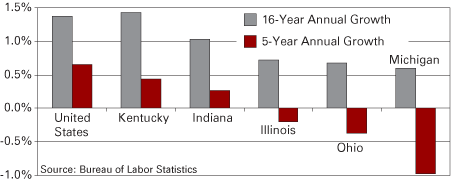
Across all Indiana metro areas, we also observe average annual growth rates for the most recent five-year period less than the longer term sixteen-year growth rate (see Figure 4). One exception was the Elkhart-Goshen metro area. Its five-year annual growth rate of 1.72 percent slightly exceeded the sixteen-year growth rate of 1.68 percent. It should also be noted that Elkhart-Goshen observed healthy gains in both manufacturing and professional and business services over the five-year and sixteen-year period.
Figure 4
Annual Growth Rates in Total Nonfarm Payroll
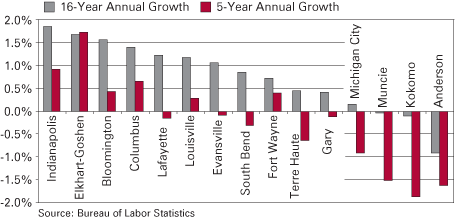
Goods-Producing
Despite the stereotypical view of declining goods-producing sectors in general, Indiana has not experienced the declines observed in neighboring states, and actually surpassed the nation in overall job growth in goods-producing sectors (see Figure 5). Growth in goods-producing sectors was nearly flat for Indiana, outperforming its neighbors. Kentucky saw declines of over 1 percent, and Ohio saw the largest decline at 18 percent.
Figure 5
Percent Change in Goods-Producing Jobs in the Midwest, 1990 to 2006
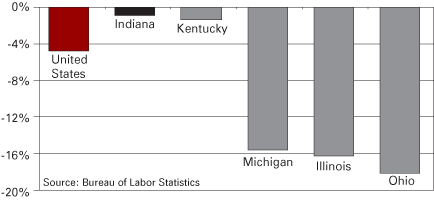
While some Indiana metro areas experienced deep declines in goods-producing sectors, other metro areas experienced significant gains; Bloomington, Columbus, Elkhart-Goshen, Evansville, Indianapolis, Lafayette, and Terre Haute all experienced positive changes (see Figure 6). Elkhart-Goshen far exceeded national and state changes with an increase of 31 percent. Metro areas showing significant declines in goods-producing payrolls include Anderson, Muncie, and Gary. Anderson saw the largest decline with a 55 percent negative change in goods-producing payrolls.
Figure 6
Percent Change in Goods-Producing Sectors in Indiana Metros, 1990 to 2006
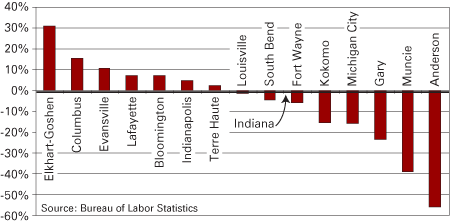
Service-Providing
Indiana’s transition to service-providing sector jobs again exceeded all neighboring states with the exception of Kentucky (see Figure 7). The addition of service-providing jobs in Indiana did not keep pace with changes in the macro-economy, however. The change in service-providing jobs for the United States stood at 32.5 percent.
Figure 7
Percent Change in Service Providing Jobs in the Midwest, 1990 to 2006
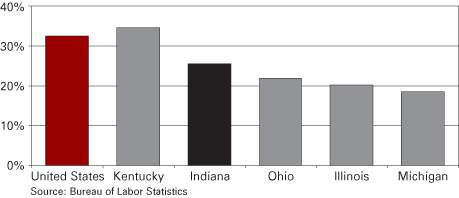
Indiana’s growth in service-providing industries was positive in all metro areas. Statewide growth in service-providing sectors was approximately 26 percent, with some metro areas significantly exceeding this level of change (see Figure 8).
Figure 8
Percent Change in Service-Providing Jobs in Indiana Metros, 1990 to 2006
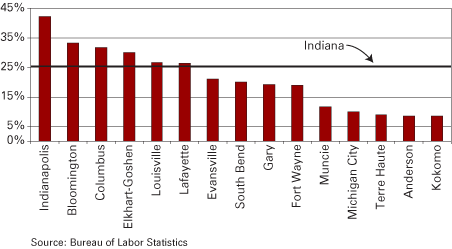
Indianapolis experienced the largest change in service-providing jobs and Bloomington, Columbus, and Elkhart-Goshen also experienced increases that exceeded the state average. Indianapolis and Bloomington were the only two metro areas where the change in service sectors exceeded the national average. Smaller increases were also evident in metro areas that observed smaller changes in nonfarm payrolls. Anderson, Kokomo, Terre Haute, and Muncie all observed changes in service-sector jobs that did not keep pace with Indiana or the U.S. economy.
Manufacturing
Indiana observed significant swings in manufacturing payrolls across metro areas. Indiana observed a 6.6 percent decline, or a total of 40,000 jobs over the sixteen-year period analyzed (see Figure 9). This percentage change in manufacturing employment pales in comparison to the national economy, and was significantly less than the three neighboring states of Illinois, Michigan, and Ohio. Manufacturing job losses for the United States stood at 20 percent and Illinois, Ohio, and Michigan all exceeded 20 percent. Kentucky job losses in manufacturing were 4 percent, slightly less than the 6.6 percent decline for Indiana.
Figure 9
Percent Change in Manufacturing Jobs in the Midwest, 1990 to 2006
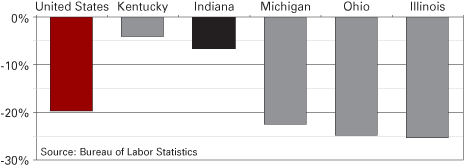
Within Indiana, the largest decrease (62 percent) in manufacturing occurred in Anderson (see Figure 10). The largest positive change occurred in the Elkhart-Goshen metro area with an increase exceeding 30 percent. Columbus, Lafayette, Terre Haute, and Evansville also registered positive changes in manufacturing employment. Anderson, Gary, Michigan City, and Muncie all declined more than the nation overall.
Figure 10
Percent Change in Manufacturing Jobs in Indiana’s Metros, 1990 to 2006
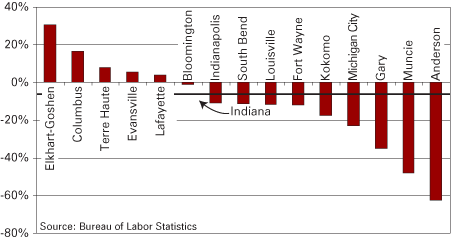
It is interesting to note that the largest positive changes in manufacturing employment were experienced by the metro areas that observed the largest changes in service-providing payrolls.
Professional and Business Services Sector
Indiana saw significant percentage gains in the professional and business services sector. Gains in the PBS sector exceeded gains in the United States and surrounding states except for Kentucky (see Figure 11). The 80 percent change for Indiana was also almost double the changes observed in Ohio and Illinois. Equally impressive, gains in certain Indiana metro areas far exceeded neighboring states and the nation as a whole (see Figure 12).
Figure 11
Percent Change in Professional and Business Services Jobs in the Midwest, 1990 to 2006
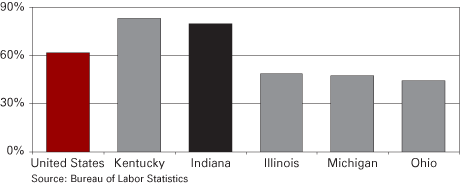
Figure 12
Percent Change in Professional and Business Services Jobs in Indiana Metros, 1990 to 2006
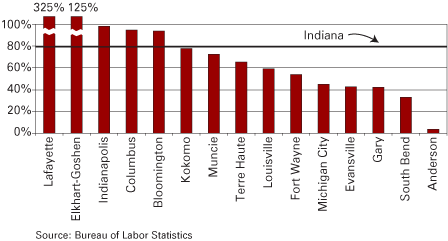
The Lafayette metro area experienced the largest percentage change in the PBS sector at 325 percent. The smallest increase in PBS sector employees was observed for the Anderson metro region. Anderson also observed the steepest decline in manufacturing jobs. While not all gains in the PBS sector were associated with positive gains in the manufacturing sector, it is interesting to note that the two largest PBS gains, Lafayette and Elkhart-Goshen, were also associated with positive gains in manufacturing. In fact, Elkhart-Goshen had the largest increase in manufacturing at 31 percent and the second largest increase in PBS growth of 125 percent. Bloomington, Columbus, Elkhart, Indianapolis, and Lafayette all experienced changes in PBS employment that exceeded Indiana and U.S. changes.
Average Weekly Wages
Across all Indiana metro areas except for Kokomo, average weekly wages for two out of the three subsectors in the PBS sector exceed the average weekly wage for that region. Wages for the professional, scientific, and technical and management of company’s subsectors exceeded the average weekly wages in each respective metro area (see Table 1).
Table 1
Average Weekly Wages in Indiana Metros, 2006
In all but one metro area, average weekly wages for the management of companies subsector exceeded average weekly wages for manufacturing. Across all metro areas, the administrative and support services was the lowest paid in terms of average weekly wages. This subsector was less than the average weekly wage in each metro across all industries. Administrative and support services jobs are generally lower skilled positions and require less preparation in terms of education and training, but do provide important support to the overall growth of the PBS sector, as well as other firms.
Conclusion
Indiana has experienced growth in the PBS sector that exceeds both national and neighboring state changes. While the overall PBS sector is small relative to traditional services of education and health care, and the goods-producing manufacturing sector, its overall comparative growth does show promise.
Given that manufacturing continues to decline, the PBS sector is a viable alternative and likewise contributes to economic development at the regional level. Economic developers in Indiana should be familiar with PBS sector growth potential in their region, and might think of explicit strategies to foster and grow this important sector.
References
- Harpel, Ellen, 2006. Professional and Business Services in Regional Economies, The IEDC Economic Development Journal, 5 (4): 50–57.
- Dice Tech Salary Survey, 2006.
- Gillis, William R., 1987. Can Service-Providing Industries Provide a Catalyst for Regional Economic Growth? Economic Development Quarterly, 1 (3): 249–256.
- Harpel, Ellen, 2006. Professional and Business Services in Regional Economies, The IEDC Economic Development Journal, 5 (4).
- Gattrell, J.D., 2002. Business Services, Productivity and Wages: Metropolitan and Nonmetropolitan Michigan Counties, 1977–1997. The Professional Geographer, 54 (3): 365-378.


